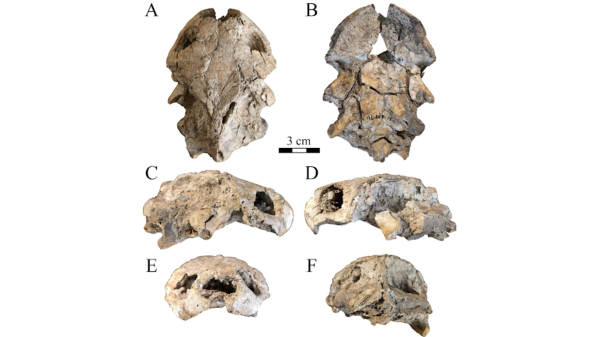As one of the world’s leading quantitative geneticists, Michael Lynch knows everything there is to know about natural evolution.
Including the fact his life hardly evolved naturally.
“I’ve thought about that quite a bit,” said Lynch, a professor in Arizona State University’s School of Life Sciences and director of the Biodesign Center for Mechanisms of Evolution. “I think there was a lot of serendipity in my life.”
That serendipity led Lynch to being named one of four new Regents Professors. He will be officially inducted on Feb. 9.
Lynch was honored not just for his research on population genetics, his 1998 book “Genetics and Analysis of Quantitative Traits” — which is considered the foundational work in quantitative genetics — or his induction into the National Academy of Sciences in 2009, but also for the leadership he has provided to 51 postdoctoral fellows, 34 PhD students and 17 master’s degree students.
“Lynch has advanced a visionary approach to uncover the fundamental mechanisms of evolution through studies of single-celled organisms, including bacteria, archaea, protozoa and fungi,” said Kenro Kusumi, dean of natural sciences in The College of Liberal Arts and Sciences. ASU and The College are thrilled to recognize the achievements by this internationally recognized scientist.”
And to think, Lynch once assumed he would work at a factory every day of his life, “waiting for retirement.”
Lynch was introduced to science at a young age growing up in Auburn, New York, just outside Syracuse. His father worked as a tool-and-dye maker, spent the last years of his career making transistors for General Electric and gave Lynch calculus books he borrowed from his engineer friends.
And like a lot of young kids with an interest in science, Lynch often performed science experiments at home.
“I had one of those little chemistry sets and sort of blew things up, mixing chemicals that shouldn’t have been mixed together,” Lynch said with a smile. “Nobody got hurt, though.
“I spent a lot of time looking in a microscope. I was able to look at all kinds of bugs that I never would’ve known existed and spent a lot of time in the woods collecting salamanders, things like that.”
Lynch never thought college was an option, though. No one in his family had ever gone to college, and his parents didn’t have the money to send him to a four-year university.
But it was the late 1960s, and America was involved in the Vietnam War. Every one of Lynch’s male predecessors had gone to war, and he thought he would be next.
But his parents had other ideas. They didn’t want him to go to Vietnam. Lynch didn’t want to go, either.
“And if you weren’t going to college, then that’s where you were headed,” Lynch said.
So, his parents started looking at colleges. Lynch wound up at St. Bonaventure (more on that in a moment), and even now, more than 50 years later, he believes that if it hadn’t been for the war, he might have gone to work in a factory and never stepped foot on a college campus.
As to why he went to St. Bonaventure, a private Franciscan university, well, that’s where a second bit of serendipity played a part. His parents didn’t really know what good colleges were around New York, but St. Bonaventure was in the news because its basketball team was ranked among the top five teams in the country, so they had a passing knowledge of the school.
Plus, Lynch’s mother was a devout Catholic and didn’t want her son to attend the state schools because, Lynch said, “they were burning buildings down during the Vietnam years, and she thought that was too radical.”
Lynch said his mom thought he would go to St. Bonaventure and become a priest.
“I don’t think she ever quite got over that, but she felt OK that I was going to be a doctor,” said Lynch, who had interest in going to medical school at the time. “And that’s prestige for the family.”
As it turned out, St. Bonaventure’s small size was ideal for Lynch. He didn’t have a lot of self-confidence growing up — “I spent a lot of time on sports teams when I was in high school and was pretty terrible at it all” — and the close-knit nature of the student body developed Lynch’s interpersonal skills.
“I had zero social skills when I went there,” he said. “One of the main things I learned there was to, I don’t know, be at least semi-competent in interacting with people.”
Lynch paid for school by working the night security shift — 1 to 6 a.m. — at local factories that made everything from typewriters to TVs to ski masks and heavy picture tubes.
During the day, he took practically every science course St. Bonaventure offered.
“I thought I would be a doctor,” he said. “I didn’t really know what research or graduate school was, so I assumed that’s what you could with a medical degree.”
In his final two years at St. Bonaventure, however, Lynch began doing field research with Professor Stephen Eaton.
“He was an amazing natural historian,” Lynch said. “He had me doing research on plankton communities in a local reservoir called the Allegheny Reservoir. I was counting different species of algae and plankton and plants. For me, that was really sort of eye-opening. That was my first real experience with research.”
As Lynch was applying for graduate programs, Eaton gave him a Science (magazine) paper on limnology, the study of the biological, chemical and physical features of lakes and other bodies of fresh water. The paper was written by Joseph Shapiro, a professor at the University of Minnesota.
“I always liked water, and I knew there were a ton of lakes up there in Minnesota so I figured it would be worth a try,” Lynch said.
Lynch’s path then became more traditional. After receiving his PhD at Minnesota, he took a job at the University of Illinois, Urbana-Champaign, and eventually moved beyond limnology to population genetics, thanks in part to a class on the subject he had audited at Minnesota.
Now, he’s one of the leaders in his field and a Regents Professor, joining a select group that makes up less than 3% of ASU’s faculty.
Evolution.
Not just in the way he ever could have imagined.
Top photo: Newly named Regents Professor Michael Lynch from the School of Life Sciences and director of the Biodesign Center for Mechanisms of Evolution. Photo by Enrique Lopez
More Science and technology

New research by ASU paleoanthropologists: 2 ancient human ancestors were neighbors
In 2009, scientists found eight bones from the foot of an ancient human ancestor within layers of million-year-old sediment in the Afar Rift in Ethiopia. The team, led by Arizona State University…

When facts aren’t enough
In the age of viral headlines and endless scrolling, misinformation travels faster than the truth. Even careful readers can be swayed by stories that sound factual but twist logic in subtle ways that…

Scientists discover new turtle that lived alongside 'Lucy' species
Shell pieces and a rare skull of a 3-million-year-old freshwater turtle are providing scientists at Arizona State University with new insight into what the environment was like when Australopithecus…
